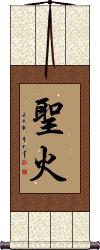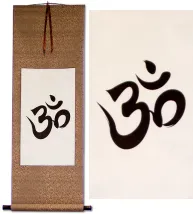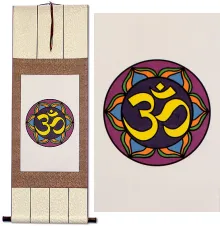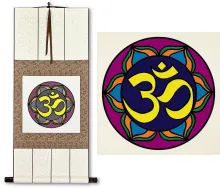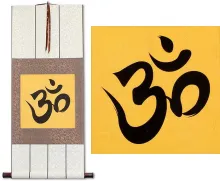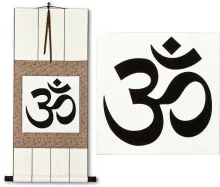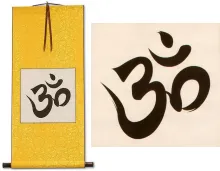Many custom options...
And formats...

Sacred Fire in Chinese / Japanese...
Buy a Sacred Fire calligraphy wall scroll here!
Personalize your custom “Sacred Fire” project by clicking the button next to your favorite “Sacred Fire” title below...
Sacred Fire
聖火 is a Chinese, Japanese and Korean term that applies to the sacred fire of the ancient Greek Olympic torch or games.
This could also apply to other sacred or holy fires, as it can be a somewhat generic term.
Phoenix Rise from the Ashes
鳳凰涅磐 is a proverb that suggests “Legendary Phoenix rises from the ashes.” It means “Legendary Phoenix [reaches] Nirvana.”
There is a legend in China of a great bird reborn once every 500 years. This bird gathers all the ill will, suffering, desire, and other negative things of the world. The bird then plunges into the fire to burn away all negative things, sacrificing itself in the process (achieving Nirvana, or perhaps allowing others the opportunity to reach Nirvana).
500 years later, the phoenix is reborn from the ashes again, and the cycle repeats.
This in-stock artwork might be what you are looking for, and ships right away...
Gallery Price: $67.00
Your Price: $36.88
Gallery Price: $200.00
Your Price: $122.88
Gallery Price: $72.00
Your Price: $39.88
Not the results for sacred fire that you were looking for?
Below are some entries from our dictionary that may match your sacred fire search...
| Characters If shown, 2nd row is Simp. Chinese |
Pronunciation Romanization |
Simple Dictionary Definition |
聖火 圣火 see styles |
shèng huǒ sheng4 huo3 sheng huo seika / seka せいか |
More info & calligraphy: Sacred Fire(1) sacred fire; sacred flame; (2) (See オリンピック聖火) Olympic flame; Olympic torch; (given name) Seika |
浄火 see styles |
jouka / joka じょうか |
sacred fire |
火種居士 火种居士 see styles |
huǒ zhǒng jū shì huo3 zhong3 ju1 shi4 huo chung chü shih Kashu koji |
Brahmans, servers of the sacred fire. |
灰 see styles |
huī hui1 hui hai はい |
More info & calligraphy: Grayash; ashes; (surname) Hai Ash; lime; hot or fiery as ashes. |
煨 see styles |
wēi wei1 wei |
to simmer; to roast in ashes |
燼 烬 see styles |
jìn jin4 chin shin |
(bound form) cinders; ashes ashes |
蓬 see styles |
péng peng2 p`eng peng yomogi よもぎ |
fleabane (family Asteraceae); disheveled; classifier for luxuriant plants, smoke, ashes, campfires: clump, puff (1) Japanese mugwort (Artemisia princeps, Artemisia indica var. maximowiczii); (2) general term for plants in the Artemisia genus; mugwort; sagebrush; wormwood; (surname, female given name) Yomogi mugwort or raspberry found growing sporadically among hemp |
三乘 see styles |
sān shèng san1 sheng4 san sheng minori みのり |
(surname) Minori Triyāna, the three vehicles, or conveyances which carry living beings across saṁsāra or mortality (births-and-deaths) to the shores of nirvāṇa. The three are styled 小,中, and 大. Sometimes the three vehicles are defined as 聲聞 Śrāvaka, that of the hearer or obedient disciple; 緣覺Pratyeka-buddha, that of the enlightened for self; these are described as 小乘 because the objective of both is personal salvation; the third is 菩薩Bodhisattva, or 大乘 Mahāyāna, because the objective is the salvation of all the living. The three are also depicted as 三車 three wains, drawn by a goat, a deer, an ox. The Lotus declares that the three are really the One Buddha-vehicle, which has been revealed in three expedient forms suited to his disciples' capacity, the Lotus Sūtra being the unifying, complete, and final exposition. The Three Vehicles are differently explained by different exponents, e.g. (1) Mahāyāna recognizes (a) Śrāvaka, called Hīnayāna, leading in longer or shorter periods to arhatship; (b) Pratyeka-buddha, called Madhyamayāna, leading after still longer or shorter periods to a Buddhahood ascetically attained and for self; (c) Bodhisattva, called Mahayana, leading after countless ages of self-sacrifce in saving others and progressive enlightenment to ultimate Buddhahood. (2) Hīnayāna is also described as possessing three vehicles 聲, 緣, 菩 or 小, 中, 大, the 小 and 中 conveying to personal salvation their devotees in ascetic dust and ashes and mental annihilation, the 大 leading to bodhi, or perfect enlightenment, and the Buddha's way. Further definitions of the Triyāna are: (3) True bodhisattva teaching for the 大; pratyeka-buddha without ignorant asceticism for the 中; and śrāvaka with ignorant asceticism for the 小. (4) (a) 一乘 The One-Vehicle which carries all to Buddhahood: of this the 華嚴 Hua-yen and 法華 Fa-hua are typical exponents; (b) 三乘法 the three-vehicle, containing practitioners of all three systems, as expounded in books of the 深密般若; (c) 小乘 the Hīnayāna pure and simple as seen in the 四阿合經 Four Āgamas. Śrāvakas are also described as hearers of the Four Truths and limited to that degree of development; they hear from the pratyeka-buddhas, who are enlightened in the Twelve Nidānas 因緣; the bodhisattvas make the 六度 or six forms of transmigration their field of sacrificial saving work, and of enlightenment. The Lotus Sūtra really treats the 三乘. Three Vehicles as 方便 or expedient ways, and offers a 佛乘 Buddha Vehicle as the inclusive and final vehicle. |
五見 五见 see styles |
wǔ jiàn wu3 jian4 wu chien gomi ごみ |
(surname) Gomi The five wrong views: (1) 身見 satkāya-dṛṣṭi, i. e. 我見 and 我所見 the view that there is a real self, an ego, and a mine and thine: (2) 邊見 antar-grāha, extreme views. e. g. extinction or permanence; (3) 邪見 mithyā, perverse views, which, denying cause and effect, destroy the foundations of morality; (4) 見取見 dṛṣṭi-parāmarśa, stubborn perverted views, viewing inferior things as superior, or counting the worse as the better; (5) 戒禁取見 śīla-vrata-parāmarśa, rigid views in favour of rigorous ascetic prohibitions, e. g. covering oneself with ashes. Cf. 五利使. |
仏牙 see styles |
butsuge ぶつげ |
{Buddh} tooth of Buddha recovered from his cremated ashes |
倶攞 see styles |
jù luó luǒ ju4 luo2 luo3 chü lo lo kura |
kūla, a slope, a shore; a mound; a small dagoba in which the ashes of a layman are kept. kula, a herd, family, household. |
分骨 see styles |
bunkotsu ぶんこつ |
(n,vs,vt,vi) (1) burying some of a person's ashes in separate places; (2) part of a person's ashes |
劫灰 see styles |
jié huī jie2 hui1 chieh hui kōkai |
kalpa-ash, the ashes after the fire kalpa of destruction. |
十地 see styles |
shí dì shi2 di4 shih ti juuji / juji じゅうじ |
{Buddh} dasabhumi (forty-first to fiftieth stages in the development of a bodhisattva); (place-name) Jūji daśabhūmi; v. 十住. The "ten stages" in the fifty-two sections of the development of a bodhisattva into a Buddha. After completing the十四向 he proceeds to the 十地. There are several groups. I. The ten stages common to the Three Vehicles 三乘 are: (1) 乾慧地 dry wisdom stage, i. e. unfertilized by Buddha-truth, worldly wisdom; (2) 性地 the embryo-stage of the nature of Buddha-truth, the 四善根; (3) 八人地 (八忍地), the stage of the eight patient endurances; (4) 見地 of freedom from wrong views; (5) 薄地 of freedom from the first six of the nine delusions in practice; (6) 離欲地 of freedom from the remaining three; (7) 巳辨地 complete discrimination in regard to wrong views and thoughts, the stage of an arhat; (8) 辟支佛地 pratyeka-buddhahood, only the dead ashes of the past left to sift; (9) 菩薩地 bodhisattvahood; (10) 佛地 Buddhahood. v. 智度論 78. II. 大乘菩薩十地 The ten stages of Mahāyāna bodhisattva development are: (1) 歡喜地 Pramuditā, joy at having overcome the former difficulties and now entering on the path to Buddhahood; (2) 離垢地 Vimalā, freedom from all possible defilement, the stage of purity; (3) 發光地 Prabhākarī, stage of further enlightenment; (4) 焰慧地 Arciṣmatī, of glowing wisdom; (5) 極難勝地 Sudurjayā, mastery of utmost or final difficulties; (6) 現前地 Abhimukhī, the open way of wisdom above definitions of impurity and purity; (7) 遠行地 Dūraṁgamā, proceeding afar, getting above ideas of self in order to save others; (8) 不動地 Acalā, attainment of calm unperturbedness; (9) 善慧地 Sādhumatī, of the finest discriminatory wisdom, knowing where and how to save, and possessed of the 十力 ten powers; (10) 法雲地 Dharmamegha, attaining to the fertilizing powers of the law-cloud. Each of the ten stages is connected with each of the ten pāramitās, v. 波. Each of the 四乘 or four vehicles has a division of ten. III. The 聲聞乘十地 ten Śrāvaka stages are: (1) 受三歸地 initiation as a disciple by receiving the three refuges, in the Buddha, Dharma, and Saṅgha; (2) 信地 belief, or the faith-root; (3) 信法地 belief in the four truths; (4) 内凡夫地 ordinary disciples who observe the 五停心觀, etc.; (5) 學信戒 those who pursue the 三學 three studies; (6) 八人忍地 the stage of 見道 seeing the true Way; (7) 須陀洹地 śrota-āpanna, now definitely in the stream and assured of nirvāṇa; (8) 斯陀含地 sakrdāgāmin, only one more rebirth; (9) 阿那含地 anāgāmin, no rebirth; and (10) 阿羅漢地 arhatship. IV. The ten stages of the pratyekabuddha 緣覺乘十地 are (1) perfect asceticism; (2) mastery of the twelve links of causation; (3) of the four noble truths; (4) of the deeper knowledge; (5) of the eightfold noble path; (6) of the three realms 三法界; (7) of the nirvāṇa state; (8) of the six supernatural powers; (9) arrival at the intuitive stage; (10) mastery of the remaining influence of former habits. V. 佛乘十地 The ten stages, or characteristics of a Buddha, are those of the sovereign or perfect attainment of wisdom, exposition, discrimination, māra-subjugation, suppression of evil, the six transcendent faculties, manifestation of all bodhisattva enlightenment, powers of prediction, of adaptability, of powers to reveal the bodhisattva Truth. VI. The Shingon has its own elaborate ten stages, and also a group 十地十心, see 十心; and there are other groups. |
吸殻 see styles |
suigara すいがら |
cigarette end; cigarette butt; tobacco ashes |
埋骨 see styles |
maikotsu まいこつ |
(n,vs,vt,vi) burial of ashes |
塗灰 涂灰 see styles |
tú huī tu2 hui1 t`u hui tu hui tokai |
to daub one's body with ashes |
尼犍 see styles |
ní jiān ni2 jian1 ni chien nikon |
nirgrantha, 尼健; 尼乾 (尼乾陀); 尼虔, freed from all ties, a naked mendicant, tr. by 離繋, 不繋, 無結 devotees who are free from all ties, wander naked, and cover themselves with ashes. Mahāvīra, one of this sect, called 若提 Jñāti after his family, and also 尼乾陀若提子 Nirgrantha-jñātiputra, was an opponent of Śākyamuni. His doctrines were determinist, everything being fated, and no religious practices could change one's lot. |
散骨 see styles |
sankotsu さんこつ |
(n,vs,vi) scattering of ashes (cremated remains) |
木灰 see styles |
kibai きばい |
wood ashes |
死灰 see styles |
shikai しかい |
as lifeless as cold ashes |
灰人 see styles |
huī rén hui1 ren2 hui jen kaito かいと |
(given name) Kaito An image of ashes or lime made and worshipped seven times a day by a woman whose marriage is hindered by unpropitious circumstances. |
灰土 see styles |
huī tǔ hui1 tu3 hui t`u hui tu haitsuchi はいつち |
dust; (soil taxonomy) spodosol ashes and earth; poor volcanic soil; (place-name) Haitsuchi |
灰塵 灰尘 see styles |
huī chén hui1 chen2 hui ch`en hui chen kaijin かいじん |
dust ashes and dust |
灰殻 see styles |
haigara はいがら |
ashes |
灰沙 see styles |
huī shā hui1 sha1 hui sha kesha |
Ascetics who cover themselves with ashes, or burn their flesh. |
灰河 see styles |
huī hé hui1 he2 hui ho kega |
A river of lava or fire, reducing all to ashes. |
灰燼 灰烬 see styles |
huī jìn hui1 jin4 hui chin kaijin かいじん |
ashes ash; embers; complete destruction is burnt to ashes |
灰蘆 灰芦 see styles |
huī lú hui1 lu2 hui lu kairo |
burnt to ashes |
灰釉 see styles |
haigusuri はいぐすり |
ash glaze (type of fundamental glaze used in ancient times made from the ashes of raw materials such as unhulled rice, straw, oak and pine) |
Click here for more sacred fire results from our dictionary
The following table may be helpful for those studying Chinese or Japanese...
| Title | Characters | Romaji (Romanized Japanese) | Various forms of Romanized Chinese | |
| Sacred Fire | 聖火 圣火 | seika | shèng huǒ sheng4 huo3 sheng huo shenghuo | |
| Phoenix Rise from the Ashes | 鳳凰涅磐 凤凰涅磐 | fèng huáng niè pán feng4 huang2 nie4 pan2 feng huang nie pan fenghuangniepan | feng huang nieh p`an fenghuangniehpan feng huang nieh pan |
|
| In some entries above you will see that characters have different versions above and below a line. In these cases, the characters above the line are Traditional Chinese, while the ones below are Simplified Chinese. | ||||
Successful Chinese Character and Japanese Kanji calligraphy searches within the last few hours...
